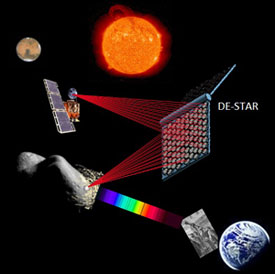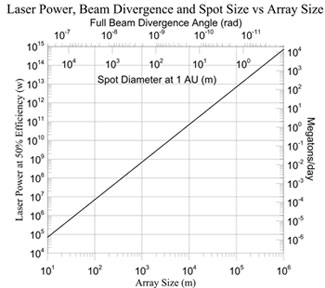Given that a meteorite exploded over Russia on Friday while the 2012 DA14 asteroid passed close to Earth, there has never been a better time to develop defensive measures against threats from space.
 Two scientists from the University of California, Santa Barbara, and California Polytechnic State University, San Luis Obispo, have conceived DE-STAR (Directed Energy Solar Targeting of Asteroids and exploRation) as a realistic means of mitigating potential threats posed to the Earth by asteroids and comets.
Two scientists from the University of California, Santa Barbara, and California Polytechnic State University, San Luis Obispo, have conceived DE-STAR (Directed Energy Solar Targeting of Asteroids and exploRation) as a realistic means of mitigating potential threats posed to the Earth by asteroids and comets.
“We need to be proactive rather than reactive in dealing with threats,” said UCSB professor Philip M. Lubin, who began work on DE-STAR a year ago. “Duck and cover is not an option. We can actually do something about it, and it’s credible to do something. So let’s begin along this path. Let’s start small and work our way up. There is no need to break the bank to start.”

Concept drawing of the DE-STAR system engaging an asteroid for evaporation or composition analysis, while it simultaneously propels an interplanetary spacecraft. Images courtesy of Philip M. Lubin.
DE-STAR, described as a “directed energy orbital defense system,” is designed to harness solar power and convert it into a phased array of laser beams that could change an asteroid’s orbit — or vaporize it completely — while gathering valuable data on its composition.
“This system is not some far-out idea from Star Trek,” said Gary B. Hughes of Cal Poly. “All the components of this system pretty much exist today. Maybe not quite at the scale that we’d need — scaling up would be the challenge — but the basic elements are all there and ready to go. We just need to put them into a larger system to be effective, and once the system is there, it can do so many things.”
The proposed system could be developed in varying sizes ranging from a desktop device to one measuring 10 km in diameter. Larger systems with greater capabilities were also considered.
Estimates suggest that DE-STAR 4 could destroy an asteroid 10 times the size of 2012 DA14 — an asteroid roughly half the size of a football field with energy equal to that of a large hydrogen bomb. DE-STAR 4 could deliver 1.4 megatons of energy per day to its target, Lubin said, obliterating an asteroid 500 m across in one year. Able to engage multiple targets and missions at once, DE-STAR 4 “is the baseline for asteroid mitigation and spacecraft propulsion," Lubin said in an email to Photonics.com. "It is not something that makes sense to build right now, though it shares the same basic technology as the smaller units. The scale-up has very significant technological hurdles, not the least of which is building something that large in orbit. This is for our children's generation to consider.
"One of the key issues is that efficiency of conversion — sunlight to electricity to laser light — is not the issue, as we are almost there already. We only assume very modest improvements in efficiency (it is close to 50 percent already, with advanced photonic devices on both sides, so you cannot improve efficiency very much. We do, however, assume massive improvements in power density of lasers (kw/kg). The best is currently about 0.2 kw/kg (e.g., DARPA Excalibur), and we assume in the next one to two decades an improvement of a factor of 50 here. This is purely for mass issues, not efficiency. Phase locking, phase stability, phase noise, etc., are real issues to be tackled.
"That is why we suggest a realistic program starts small: DE-STAR 0 that then leads to a DE-STAR 1, etc."

This plot shows DE-STAR laser power and spot diameter versus DE-STAR array size. The DE-STAR system is modular and can be built up in sections, each of which is immediately operational.
Larger still, DE-STAR 6 could function both as an orbiting power source and as a propulsion system, meaning that it might allow for interstellar travel.
“Our proposal assumes a combination of baseline technology — where we are today — and where we almost certainly will be in the future, without asking for any miracles,” Lubin said. “We’ve really tried to temper this with a realistic view of what we can do, and we approached it from that point of view. It does require very careful attention to a number of details, and it does require a will to do so, but it does not require a miracle.”
"This is meant to be science-fact-based, not science fiction," Lubin added.
“There are large asteroids and comets that cross the Earth’s orbit, and some very dangerous ones [are] going to hit the Earth eventually,” Hughes said. “Many have hit in the past, and many will hit in the future. We should feel compelled to do something about the risk. Realistic solutions need to be considered, and this is definitely one of those.”
For more information, visit: www.ucsb.edu